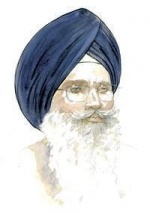Template:AOW6: Difference between revisions
Hari singh (talk | contribs) No edit summary |
Hari singh (talk | contribs) mNo edit summary |
||
| Line 1: | Line 1: | ||
[[Image:Turban sikh.jpg|thumb|150px|right|Sikh man with a Turban and uncut beard]] | [[Image:Turban sikh.jpg|thumb|150px|right|Sikh man with a Turban and uncut beard]] | ||
[[Turban]] is closely associated with [[Sikhism]]. Sikhism is the only religion in the world in which wearing a [[turban]] is mandatory. Vast majority of people who wear turbans in the Western countries are [[Sikh]]s. The Sikh ''pagdi'' (ਪਗੜੀ)(turban) is also called ''dastaar'' (ਦਸਤਾਰ), which is a more respectful word in [[Punjabi]] for the turban. Sikh's are famous for their distinctive turbans. The turban represents respectability, and is a sign of nobility. [[Guru Gobind Singh]] gave all of his [[Sikh]]s turbans to recognize the the high moral status that the [[Khalsa]] has to adhere to. '''[[Turban| Continued.....]]''' | '''[[Turban]]''' is closely associated with [[Sikhism]]. Sikhism is the only religion in the world in which wearing a [[turban]] is mandatory. Vast majority of people who wear turbans in the Western countries are [[Sikh]]s. The Sikh ''pagdi'' (ਪਗੜੀ)(turban) is also called ''dastaar'' (ਦਸਤਾਰ), which is a more respectful word in [[Punjabi]] for the turban. Sikh's are famous for their distinctive turbans. The turban represents respectability, and is a sign of nobility. [[Guru Gobind Singh]] gave all of his [[Sikh]]s turbans to recognize the the high moral status that the [[Khalsa]] has to adhere to. '''[[Turban| Continued.....]]''' | ||
'''Previous Featured article:''' | '''Previous Featured article:''' | ||
Revision as of 23:14, 24 October 2005
Turban is closely associated with Sikhism. Sikhism is the only religion in the world in which wearing a turban is mandatory. Vast majority of people who wear turbans in the Western countries are Sikhs. The Sikh pagdi (ਪਗੜੀ)(turban) is also called dastaar (ਦਸਤਾਰ), which is a more respectful word in Punjabi for the turban. Sikh's are famous for their distinctive turbans. The turban represents respectability, and is a sign of nobility. Guru Gobind Singh gave all of his Sikhs turbans to recognize the the high moral status that the Khalsa has to adhere to. Continued.....
Previous Featured article:
Women in Sikhism: In Sikhism, the Sikh women are regarded as equal with men and have all the rights and privileges enjoyed by men. The woman is considered to have the same soul as man and has equal right to grow spiritually. The Sikh woman is allowed to lead religious congregations, to take part in Akhand Path (the continuous recitation of the Holy Scriptures), to perform Kirtan, to work as Granthi (priest) or a preacher and to participate freely in all religious, cultural, social, political and secular activities. Continued.....
Baba Farid When Farid Ji was just a few years old, his mother taught him his prayers. The boy asked what was gained by his prayes. His mother replied 'sugar'. Accordingly, she used to hide some sugar under his prayer-carpet, and when he had finished his prayers, she would draw the mat forth, and give the sugar to Farid as a reward for his devotion. On one occasion, when his mother was absent, he prayed a great deal, and, it is said, a great supply of sugar - a miraculous gift from God - was found under his carpet. Some he ate himself and the rest he gave to his playfellows. He related the circumstance to his mother on her return. It was then his mother gave him the surname Shakar Ganj, meaning a "treasury of sugar". There are 134 hymns of Baba Farid ji incorporated in the Guru Granth Sahib. Continued.....

